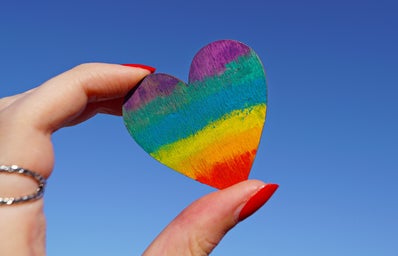As Pride Month continues, I am reminded of when one of my best friends confided in me in the seventh grade that she liked both boys and girls. My initial response was comically clueless: “Well yeah, everyone is attracted to boys and girls. You just have to pick which one you want to stick with.” At 13 years old, I already suffered from internalized biphobia – the belief that attraction to one gender is the only valid form of sexual attraction. In fact, I didn’t even know what bisexuality was until my friend came out. The word itself evoked a strange set of images in my head. Among which lived bicycles, dating two people at the same time, and suddenly dumping a partner because you had “changed your mind” about either guys or gals.
These beliefs reflect society’s overall attitudes towards bisexuality. People tend to think on a black-and-white spectrum; after all, it’s easier to process things that way. So, when a same-sex couple is shown in the media or seen walking down the street, the automatic assumption for many is that both partners are gay. In addition, movies and TV shows rarely feature bisexual characters, further cementing in audience’s minds that bisexuality is an invalid sexual orientation. It made sense for seventh grade me to assume, then, that even if someone is sexually attracted to men and women, they must “pick a side” by labeling themselves as either gay or straight.
Of course, after a few weeks’ time, my head and my heart had warmed up to the idea of bisexuality. After all, it meant that perhaps I didn’t have to face the decision of choosing either boys or girls. It meant that I could like both, which of course provided a pure, beautiful relief.
Well, for the most part. I was still confused in many ways. I remember frantically trying to calculate how much I liked men and how much I liked women. Was I 75% attracted to men and 25% attracted to women? Or was the ratio closer to 50/50? My anxious mind was convinced that I needed answers to these questions. After I officially came out, the world was sure to interrogate me, right?
Actually, in a way, yes. Bisexual people face constant streams of questions in their lives. A few months ago, after a floormate came out as bisexual, he was met with responses that sounded something like this: “Well, how do you know for sure that you’re bi?” “Is it better to be with a girl or a guy, in your opinion?” “Would you rather lose your virginity to a man or a woman?” For the record, he handled the situation like a champ. But coming out is not an open invitation for an interview on one’s sexuality, and he shouldn’t have been met with a deluge of questions in replace of statements of support and affirmation.
This perverted curiosity is not the only obstacle we face. Bisexual people are often either labeled as “sluts” or dismissed as merely confused. We are told that we’re “going through a phase.” All throughout high school, I wondered if it was true, if I only thought I was attracted to women because of the media. After all, women are often sexualized in movies and TV shows, made out to be some sort of desirable prize or accomplishment that the hero wins. Was it possible that I only believed I liked women because women are portrayed as sexual objects, closer to trophies than human beings?
No, I decided. The way I feel towards women is analogous to the way I feel towards men – not exactly the same, but just about as close as you can get. I once saw a Tumblr post that likened attraction towards women to a feeling of “ooh” and attraction towards men to a feeling of “ahh” – intuitively and inexplicably different, and yet still involving the same general idea.
This doesn’t mean that I was suddenly comfortable approaching women and dating them. In fact, I was terrified and pessimistic of what others would think. If I were to become involved with a woman, people would surely think that my previous interactions with men were completely invalid. They’d think that I had converted to lesbianism, like it was some sort of religion I could choose. Ex-flings would insist that things hadn’t worked because I had been secretly gay while with them. Even if I was ready to overcome my own internalized biphobia, the rest of the world wasn’t— and still isn’t— so ready to give it up.
There’s still much progress to be made in regards to biphobia. Sexual education classes can and should address the validity of bisexuality and bust the myths about “picking sides” or “having a phase.” But the world is certainly making some big steps – after all, it was only 7 years ago when same-sex marriage became legalized in all 50 states, and the LGBTQ+ community is still fighting viciously for equal treatment and an end to homophobia.
On a much smaller scale, I know that 13-year-old me would be proud to see where I am today in regards to embracing my sexuality and overcoming my own biphobia. I know that not everyone had the same experience I did, but we all face our own obstacles in accepting certain parts of ourselves, and I wish everyone the best of luck in their journeys to do so. Here’s to a better future for all of us.
Resources:
LGBT National Hotline: 888-843-4564
Bisexual Resource Center: https://biresource.org/

